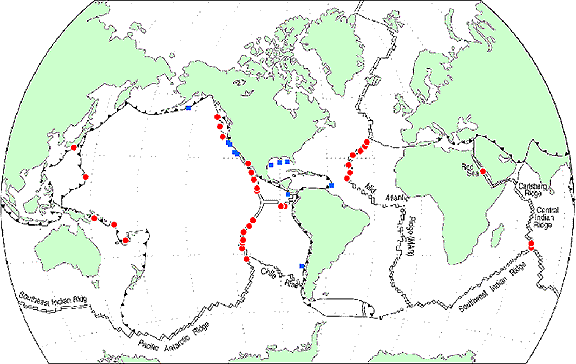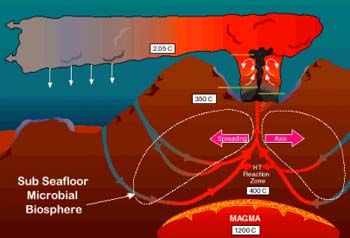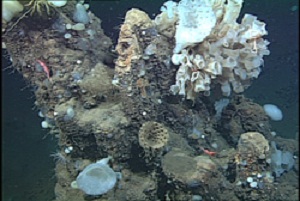 | Submarine Volcanism: Mid-Ocean Ridge Hydrothermal System |
Hydrothermal viens |
|
Animals on a hydrothermal vent chimney on Gorda Image © 2000 MBARI |
from MBARI -http://www.mbari.org/volcanism/Ridge/R-Hydrothermal.htm
Black smokers were first discovered at 21oN along the East Pacific Rise in 1979. Since then, hydrothermal vents have been found at many points along the Earth''s mid-ocean spreading ridges. They are important for many reasons, including global fluxes of elements, deposits of economically-valuable minerals, and diverse assemblages of previously unknown animals and bacteria that are supported by the chemically-rich waters emanating from the vents.
The fluids are derived from seawater that circulates through the brittle upper ocean crust. When the fluids become heated by the magma chamber at the mid-ocean ridge they become buoyant and vent at the sea floor much like geysers do on land. While circulating, the fluids react with the surrounding rocks and pick up metals and volatiles. When the hot water vents and contacts cold seawater, minerals precipitate to form the black "smoke" and build chimneys. Dissolved elements are transported in a buoyant plume that rises above the vent site and may take years to dissipate.
Tiburon sampling hydrothermal vent fluids for gas analysis in front of a clump of Riftia tubeworms. The NESCA site (stands for Northern Escanaba Trough) on the Gorda Ridge was first sampled in 1988. We returned to the NESCA vents in 2000 and 2002 (see cruise log book pages for Tiburon dives 197, 449, 452) to see what changes in temperature and chemistry had occurred over the years.
Photo © MBARI 2000
Our research on hydrothermal systems at mid-ocean ridges
The discussions below are paraphrased from abstracts of papers published by the Submarine Volcanism group.
Hydrothermal deposits
BLANCO FRACTURE ZONE - A Tiburon ROV dive within the East Blanco Depression (EBD) increased the mapped extent of a known hydrothermal field by an order of magnitude. In addition, a unique opal-CT (cristobalite-tridymite)-hematite mound was discovered, and mineralized sediments and rock were collected and analyzed. Silica-hematite mounds have not previously been found on the deep ocean floor. The light-weight rock of the porous mound consists predominantly of opal-CT and hematite filaments, rods, and strands, and averages 77.8% SiO2 and 11.8% Fe2O3. The hematite and opal-CT precipitated from a low-temperature (>115o C), strongly oxidized, silica- and iron-rich, sulfur-poor hydrothermal fluid; a bacterial mat provided the framework for precipitation. Samples collected from a volcaniclastic rock outcrop consist primarily of quartz with lesser plagioclase, smectite, pyroxene, and sulfides; SiO2 content averages 72.5%. Formation of these quartz-rich samples is best explained by cooling in an up-flow zone of silica-rich hydrothermal fluids within a low permeability system. Opal-A, opal-CT, and quartz mineralization found in different places within the EBD hydrothermal field likely reflects decreasing silica saturation and increasing temperature of the mineralizing fluid with increasing silica crystallinity. Six push cores recovered gravel, coarse sand, and mud mineralized variously by Fe or Mn oxides, silica, and sulfides. Total rare-earth element concentrations are low for both the rock and push core samples. Ce and Eu anomalies reflect high and low temperature hydrothermal components and detrital phases. A remarkable variety of types of mineralization occur within the EBD field, yet a consistent suite of elements is enriched (relative to basalt and unmineralized cores) in all samples analyzed: Ag, Au, S, Mo, Hg, As, Sb, Sr, and U; most samples are also enriched in Cu, Pb, Cd, and Zn. On the basis of these element enrichments, the EBD hydrothermal field might best be described as a base- and precious-metal-bearing, silica- Fe-oxide-barite deposit. Such deposits are commonly spatially and temporally associated with volcanogenic massive sulfide (VMS) ores. A plot of data for pathfinder elements shows a large hot spot at the northwestern margin of the field, which may mark a region where moderate to high temperature sulfide deposits are forming at depth; further exploration of the hydrothermal field to the northwest is warranted.
Reference: Hein, J.R., D.A. Clague, R.A. Koski, R.W. Embley, R.E. Dunham (2008) Metalliferous sediment and a silca-hematite deposit within the Blanco Fracture Zone, Northeast Pacific, Marine Georesources and Geotechnology, 26:317339.
Subsurface conditions
GORDA RIDGE - We report here the first compositional data for fluids from the Sea Cliff hydrothermal field, northern Gorda Ridge, collected in 2000, 2002, and 2004. An unusual aspect of this site is its location ~2.6 km east of the axis of spreading, leading to speculation since its discovery in 1988 that this may be an older hydrothermal field, as it occurs on crust that the spreading rate would predict to be ~100,000 years old. Our results suggest this hydrothermal system is being driven by subsurface magma, as evidenced by (1) elevated 3He/heat ratios, (2) relatively high concentrations of He, and (3) chloride contents less than seawater in the hydrothermal fluids. The measured fluid temperatures were ≤308°C, but we infer they were >400°C at depth. In spite of these elevated temperatures, the fluids exiting from these vents are clear, a consequence of extremely low transition metal concentrations. We attribute the low transition metal contents to loss of these metals below the seafloor, most likely as a result of the slightly elevated pH of the fluids. Neither the fluid compositions nor the setting provides evidence that buried sediments and/or organic matter are responsible for raising the fluid pH. Our favored explanation for the elevated pH is that calcite, deposited as a vein-filling mineral at this site, perhaps when it was closer to the axis and a hydrothermal downflow zone, is currently being dissolved by the hydrothermal fluids. This hypothesis is supported by our geochemical modeling results that suggest the fluids are close to saturation with calcite at in situ conditions. Elevated fluid pH is observed at a number of hydrothermal sites on the global mid-ocean ridge system, and the reason for this has not been well understood. Dissolution of previously deposited calcite may be a heretofore unrecognized mechanism that can explain these observations. Finally, our data suggest the compositions of these fluids are unchanged from 2002 to 2004 and are consistent with water column observations first made at this site in 1985. We therefore interpret the Sea Cliff site to be another hydrothermal area marked by long-term stability in fluid compositions and temperatures.
Reference: Von Damm, K. L., C. M. Parker, M. D. Lilley, D. A. Clague, R. A. Zierenberg, E. J. Olson, and J. S. McClain (2006), Chemistry of vent fluids and its implications for subsurface conditions at Sea Cliff hydrothermal field, Gorda Ridge, Geochem. Geophys. Geosyst., 7, Q05005, doi:10.1029/2005GC001034
Stability and complexity
GORDA RIDGE The composition and temperature of vent fluids sampled with ROV Tiburon from the active hydrothermal system in Escanaba Trough, Gorda Ridge in 2000 and 2002 remain unchanged from the only time this field was previously sampled, in 1988. Ocean Drilling Project (ODP) Leg 169 drilled nine bore holes at this site in 1996, some within meters of the vents, yet this disturbance has not impacted the measured compositions or temperatures of the fluids exiting at the seafloor. The fluids have maximum measured temperatures of 218°C and contain ~20% more chloride than local ambient seawater. Our interpretation is that the fluid compositions are generated by supercritical phase separation of seawater, with much of the water-rock reaction occurring within the ~400m thick sedimentary section that overlies the basalt at this site. The ODP drilling results provide information on the mineralogy and composition of materials below the seafloor, as well as direct constraints not typically available on the physical conditions occurring below the seafloor hydrothermal system. Calculations utilizing geochemical modeling software suggest the fluids are close to saturation with a suite of minerals found subsurface, suggesting equilibrium between the fluids and substrate. These results provide an explanation for why the fluids have remained chemically stable for 14 yrs. The pore water data from drilling suggest that the hydrology and chemistry of the hydrothermal system are much more complex within the sediment cover than would be expected from the surface manifestations of the hydrothermal system. While the pore waters have chloride contents both greater and less than the local seawater, only fluids with higher chloride contents vent at the seafloor. Our calculations suggest that at the current conditions the brines (fluids with chlorinity greater than seawater) are actually less dense than the vapors (fluids with chlorinity less than seawater). These density relationships may provide an explanation for why the brines are now venting preferentially to the vapors, a situation opposite to what is usually observed or inferred.
Reference: Von Damm, K.L., C.M. Parker, R.A. Zierenberg, M.D. Lilley, E.J. Olson, D.A. Clague and J.S. McClain (2005) The Escanaba Trough, Gorda Ridge hydrothermal system: Temporal stability and subseafloor complexity, Geochimica et Cosmochimica Acta, 69:21, 4971-4984


